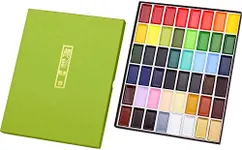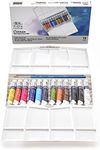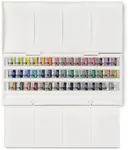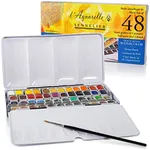Buying Guide for the Best Watercolour Paints
Choosing the right watercolor paints can greatly enhance your painting experience and the quality of your artwork. Watercolor paints come in various forms and qualities, and understanding the key specifications can help you select the best fit for your artistic needs. Consider what you want to achieve with your paintings, whether it's vibrant colors, subtle washes, or detailed work, and let that guide your choices.Quality (Artist vs. Student Grade)Watercolor paints are generally categorized into artist-grade and student-grade. Artist-grade paints contain higher concentrations of pigment and offer superior color vibrancy and permanence. They are ideal for professional artists or those looking to create high-quality artwork. Student-grade paints are more affordable and have less pigment concentration, making them suitable for beginners or casual painters. If you're just starting out or painting for fun, student-grade paints might be sufficient. However, if you're aiming for professional results, investing in artist-grade paints is recommended.
Pigment ConcentrationPigment concentration refers to the amount of pigment in the paint compared to fillers and binders. Higher pigment concentration results in more vibrant and intense colors. Paints with high pigment concentration are ideal for artists who want bold and striking colors in their work. If you prefer subtle washes and gentle transitions, paints with lower pigment concentration might be more suitable. Consider your style and the effect you want to achieve when choosing the pigment concentration.
TransparencyTransparency in watercolor paints determines how much the underlying paper or previous layers show through the paint. Transparent paints allow for layering and glazing techniques, creating depth and complexity in your artwork. Opaque paints cover previous layers more completely, which can be useful for certain techniques or effects. If you enjoy layering and creating intricate details, opt for transparent paints. If you prefer bold, solid colors, opaque paints might be more appropriate.
LightfastnessLightfastness is a measure of how resistant a paint's color is to fading when exposed to light over time. High lightfastness ensures that your artwork will maintain its original colors for years to come. This is particularly important for artists who sell their work or display it in well-lit areas. If your paintings are intended for long-term display or sale, choose paints with high lightfastness ratings. For practice or temporary projects, lightfastness may be less critical.
Color RangeThe color range refers to the variety of colors available in a set or brand of watercolor paints. A wide color range offers more options for mixing and creating unique shades, which can be beneficial for artists who enjoy experimenting with color. If you have a specific palette in mind or prefer working with a limited set of colors, a smaller range might suffice. Consider your artistic goals and how much flexibility you want in your color choices when selecting a color range.
Form (Pan vs. Tube)Watercolor paints come in two main forms: pans and tubes. Pans are solid blocks of paint that are activated with water, making them portable and convenient for travel or outdoor painting. Tubes contain liquid paint and offer more control over the amount of paint used, which can be advantageous for larger works or detailed techniques. If you paint on the go or prefer a compact setup, pans might be ideal. If you work in a studio or need precise control over paint quantities, tubes could be a better choice.

















